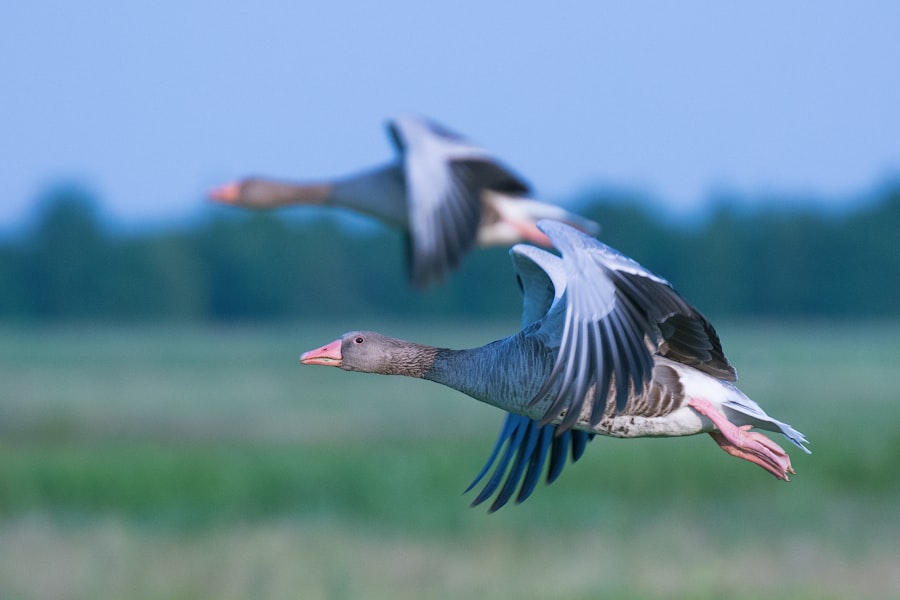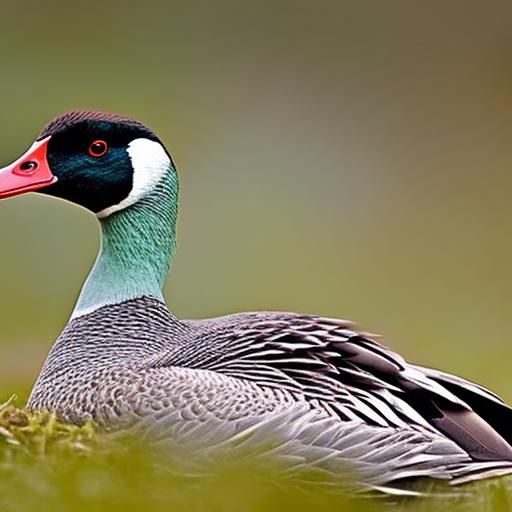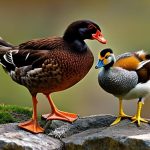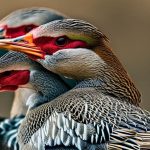Geese can be a nuisance for many reasons. One of the main issues is their droppings, which can be unsightly and difficult to clean up. Not only are goose droppings unsightly, but they can also pose health risks as they can contain bacteria and parasites that can be harmful to humans. In addition to their droppings, geese can also be aggressive, especially during nesting season. They may hiss, bite, or chase after people or other animals that they perceive as a threat. This aggressive behavior can be intimidating and potentially dangerous. Furthermore, geese can cause damage to property, such as lawns, gardens, and golf courses, by trampling on vegetation and digging up the ground in search of food.
Key Takeaways
- Geese can be a problem due to their droppings, aggressive behavior, and potential health risks.
- Understanding geese behavior and habits can help in choosing the most effective deterrent.
- Natural deterrents such as landscaping and habitat modification can discourage geese from settling in an area.
- Physical barriers like fencing and netting can prevent geese from accessing certain areas.
- Visual deterrents like decoys and scarecrows can trick geese into thinking an area is unsafe.
Understanding Geese Behavior and Habits
To effectively deter geese, it is important to understand their behavior and habits. Geese are migratory birds that typically mate for life and return to the same nesting grounds each year. They prefer open areas near water, such as ponds, lakes, and rivers, where they can find food and build their nests. Geese are herbivores and primarily feed on grasses, grains, and aquatic plants. They are also attracted to areas with short grass, as it allows them to easily spot potential predators.
During nesting season, which typically occurs in the spring, geese become more territorial and protective of their nests. They will aggressively defend their nesting area and may attack anyone or anything that comes too close. Geese nests are usually built on the ground near water, often in tall grass or shrubs for added protection.
Natural Deterrents: Landscaping and Habitat Modification
One way to deter geese from nesting or feeding in certain areas is through landscaping and habitat modification. By making changes to the environment that make it less attractive to geese, you can discourage them from staying in the area. For example, planting tall grasses or shrubs around ponds or lakes can make it more difficult for geese to access the water and build their nests. Additionally, creating barriers, such as rocks or fencing, around potential nesting sites can prevent geese from establishing their nests.
Another effective method is to modify the habitat by reducing the availability of food sources. This can be done by mowing grass to a longer length, as geese prefer short grass where they can easily spot predators. Planting native plants that are less palatable to geese can also help deter them from feeding in certain areas.
Physical Barriers: Fencing and Netting
Physical barriers, such as fencing and netting, can be effective in preventing geese from entering certain areas. Fencing can be used to create a physical barrier around ponds, lawns, or gardens, preventing geese from accessing these areas. The fence should be at least three feet high and have small enough gaps to prevent geese from squeezing through.
Netting can also be used to cover areas where geese are causing damage, such as gardens or crops. The netting should be securely fastened to prevent geese from getting underneath it. It is important to regularly check and maintain the fencing or netting to ensure its effectiveness.
Visual Deterrents: Decoys and Scarecrows
Visual deterrents can be used to visually deter geese from certain areas. One common method is the use of decoys, such as plastic owls or coyotes, which can create the illusion of a predator in the area. Geese are naturally wary of predators and will avoid areas where they perceive a threat. It is important to regularly move the decoys around to prevent geese from becoming accustomed to their presence.
Scarecrows can also be effective in deterring geese. These can be made from old clothes stuffed with straw or other materials and placed in areas where geese are causing problems. The scarecrows should be moved regularly to maintain their effectiveness.
Auditory Deterrents: Noise-Making Devices and Ultrasonic Repellents

Auditory deterrents can be used to deter geese with sound. Noise-making devices, such as propane cannons or air horns, can be effective in scaring geese away. These devices produce loud noises that startle the geese and make them uncomfortable, causing them to leave the area. It is important to use these devices sparingly and at random intervals to prevent geese from becoming accustomed to the noise.
Ultrasonic repellents emit high-frequency sounds that are inaudible to humans but can be irritating to geese. These devices can be placed near areas where geese are causing problems and can help deter them from staying in the area. It is important to position the ultrasonic repellents strategically to ensure maximum effectiveness.
Chemical Deterrents: Repellent Sprays and Gels
Chemical deterrents, such as repellent sprays and gels, can be used to discourage geese from feeding or nesting in certain areas. These products contain ingredients that are unpleasant or irritating to geese, causing them to avoid the treated areas. Repellent sprays can be applied to grass, plants, or other surfaces where geese are causing damage. Gel repellents can be applied to surfaces such as docks or lawns to create a sticky barrier that is uncomfortable for geese.
It is important to choose repellents that are safe for the environment and non-toxic to humans and other animals. Follow the instructions carefully when applying repellents and reapply as needed.
Electronic Deterrents: Sonic and Ultrasonic Devices
Electronic deterrents, such as sonic and ultrasonic devices, can be used to deter geese with sound. Sonic devices emit sounds that mimic the distress calls of geese or other predators, which can scare geese away. These devices can be placed near areas where geese are causing problems and can help deter them from staying in the area.
Ultrasonic devices emit high-frequency sounds that are inaudible to humans but can be irritating to geese. These devices can be placed near areas where geese are causing problems and can help deter them from staying in the area. It is important to position the electronic deterrents strategically to ensure maximum effectiveness.
Human Intervention: Scaring and Harassment Techniques
Human intervention, such as scaring and harassment techniques, can be used to deter geese. This can involve physically chasing or herding geese away from certain areas. It is important to approach geese slowly and calmly, as sudden movements or loud noises can startle them and cause them to become more aggressive.
Another method is to use trained dogs to chase geese away. Border collies, in particular, are known for their ability to effectively herd geese without causing harm. It is important to use trained dogs and not allow them to harm or harass the geese.
Choosing the Best Geese Deterrent for Your Needs
When choosing a geese deterrent, it is important to consider your specific needs and the severity of the problem. Some methods may be more effective than others depending on the situation. For example, if you have a small garden that is being damaged by geese, physical barriers such as netting or fencing may be the best option. On the other hand, if you have a large open area such as a golf course or park, a combination of visual, auditory, and human intervention methods may be necessary.
It is also important to consider the potential impact on other wildlife and the environment when choosing a geese deterrent. Some methods, such as chemical repellents, may have unintended consequences and should be used with caution. It is always best to choose methods that are safe and non-toxic to humans and other animals.
In conclusion, geese can be a nuisance due to their droppings, aggressive behavior, and damage to property. Understanding geese behavior and habits can help in effectively deterring them. There are various types of geese deterrents available, including natural deterrents such as landscaping and habitat modification, physical barriers such as fencing and netting, visual deterrents such as decoys and scarecrows, auditory deterrents such as noise-making devices and ultrasonic repellents, chemical deterrents such as repellent sprays and gels, electronic deterrents such as sonic and ultrasonic devices, and human intervention techniques such as scaring and harassment. When choosing a geese deterrent, it is important to consider your specific needs and the severity of the problem, as well as the potential impact on other wildlife and the environment.
If you’re looking for effective ways to keep geese away from your garden or chicken coop, you might find this article on Poultry Wizard helpful. It provides valuable insights on how to create a garden chicken coop that can deter geese and other unwanted visitors. From choosing the right size for your chicken coop door to designing the floor of the coop, this article covers various aspects that can contribute to keeping geese at bay. Check it out here for practical tips and strategies.
FAQs
What are some natural ways to keep geese away?
Some natural ways to keep geese away include using decoys, planting certain types of vegetation, and using noise deterrents.
What are some man-made ways to keep geese away?
Some man-made ways to keep geese away include using physical barriers, such as fences or netting, and using chemical repellents.
What are some common reasons why geese become a problem?
Geese can become a problem when they damage crops, leave droppings in public areas, and become aggressive towards humans.
Are there any legal restrictions on how to keep geese away?
Yes, there may be legal restrictions on how to keep geese away, depending on the location and the methods used. It is important to check with local authorities before implementing any deterrents.
What are some long-term solutions for keeping geese away?
Some long-term solutions for keeping geese away include habitat modification, such as altering the landscape to make it less attractive to geese, and implementing population control measures.
Meet Walter, the feathered-friend fanatic of Florida! Nestled in the sunshine state, Walter struts through life with his feathered companions, clucking his way to happiness. With a coop that’s fancier than a five-star hotel, he’s the Don Juan of the chicken world. When he’s not teaching his hens to do the cha-cha, you’ll find him in a heated debate with his prized rooster, Sir Clucks-a-Lot. Walter’s poultry passion is no yolk; he’s the sunny-side-up guy you never knew you needed in your flock of friends!







